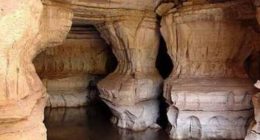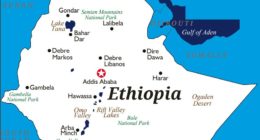The Afar Regional State is one of the nine regional states of Ethiopia, and is the homeland of the Afar people. Formerly known as Region 2, its new capital as of 2007 is the recently constructed city of Semera, which lies on the paved Awash–Assab highway.
The Afar Triangle, the northern part of which is the Danakil Depression, is part of the Great Rift Valley of Ethiopia, and is located in the north of the region. It has the lowest point in Ethiopia and one of the lowest in Africa. The southern part of the region consists of the valley of the Awash River, which empties into a string of lakes along the Ethiopian-Djibouti border. Other notable landmarks include the Awash and Yangudi Rassa National Parks.
Danakil Depression
The Danakil Depression is the northern part of the Afar Triangle or Afar Depression in Ethiopia, a geological depression that has resulted from the divergence of three tectonic plates in the Horn of Africa.
The Danakil Depression lies at the triple junction of three tectonic plates and has a complex geological history. It has developed as a result of Africa and Asia moving apart, causing rifting and volcanic activity. Erosion, inundation by the sea, the rising and falling of the ground have all played their part in the formation of this depression. Sedimentary rocks such as sandstone and limestone are unconformably overlain by basalt which resulted from extensive lava flows.
- The Danakil Depression is ranked as the hottest place on the planet and sits on the high Ethiopian escarpment near the shores of the Red Sea in the northeastern part of the country.
- Sadly, there are no rains for a consecutive nine months of the year, with temperatures rising to 50°C.
- Most of the areas around the depression are made up of rugged and dry rocks and are therefore below sea level.
- The most pleasant and favorable time of the year to visit the depression is from November to early January when temperatures are quite convenient and have dropped below 120°F.
Geology and Location
The Danakil Depression is a vast plain, some 200 by 50 km (124 by 31 mi), lying in the north of the Afar Region of Ethiopia, near the border with Eritrea. It is about 125 m (410 ft) below sea level and is bordered to the west by the Ethiopian Plateau and to the east by the Danakil Alps, beyond which is the Red Sea.
The area is often referred to as the cradle of humanity; in 1974 Donald Johanson and his colleagues found the famous Australopithecus fossil Lucy, which has been dated 3.2 million years old and many other fossils of ancient hominins have been uncovered here, prompting many palaeontologists to propose that this area is where the human species first evolved.






